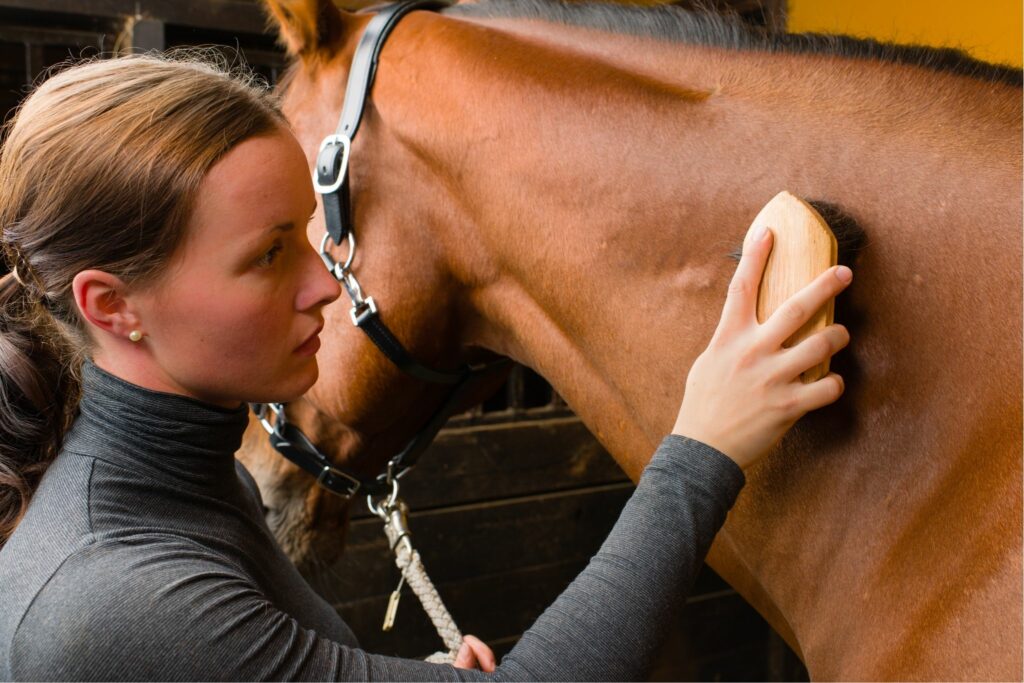Grooming is not merely a cosmetic ritual for horses; it’s an essential practice that significantly impacts their health and well-being. Whether you’re a beginner in the horse world or an experienced equestrian looking to hone your skills, this article serves as a comprehensive guide to horse grooming. We’ll delve into why it’s essential, the tools required, techniques to master, and tips for a successful grooming session.
The Importance of Horse Grooming
- Skin Health: Regular grooming removes dirt, sweat, and dead skin.
- Coat Condition: Grooming helps distribute natural oils, giving the coat a healthy shine.
- Early Detection: You can spot issues like cuts, abrasions, or skin infections early.
- Bonding: Grooming establishes trust and strengthens the human-horse relationship.
Essential Grooming Tools
- Curry Comb: For removing loose hair and dirt.
- Dandy Brush: To flick away dirt and dust.
- Body Brush: For finishing touches and sensitive areas.
- Mane and Tail Comb: To detangle the mane and tail.
- Hoof Pick: For cleaning the hooves.
- Sponges: For eyes, nose, and other delicate regions.
Basic Grooming Techniques
Brushing
- Use the Curry Comb: In a circular motion to loosen dirt and dead skin.
- Apply the Dandy Brush: With flicking strokes to remove the dirt lifted by the curry comb.
- Finish with Body Brush: To smooth the coat and distribute oils.
Mane and Tail Care
- Detangling: Use a mane and tail comb to remove knots.
- Conditioning: Apply a horse-friendly conditioner for easier management.
Hoof Cleaning
- Lift the Hoof: And use a hoof pick to remove stones, dirt, and debris.
- Inspect for Issues: Like cracks, thrush, or punctures.
Facial Care
- Use a Damp Sponge: To clean around the eyes and nostrils.
- Soft Brush: For the forelock and jaw area.
Advanced Grooming Techniques
- Clipping: Some horses may require hair clipping around the ears, muzzle, and fetlocks.
- Bathing: Use equine-specific shampoo and conditioner.
- Sheath Cleaning: A specialized task often best left to professionals or undertaken under professional guidance.
Common Mistakes to Avoid
- Skipping Hoof Care: Neglecting hooves can lead to severe health issues.
- Over-Bathing: Excessive washing can strip natural oils.
- Using Human Products: These can be irritating to a horse’s skin.
Tips for Effective Grooming
- Regular Schedule: Make grooming a part of your daily routine.
- Seasonal Adjustments: Adapt your grooming routine according to the season.
- Be Thorough: Always check for ticks, lumps, or any signs of discomfort.
When to Seek Professional Help
- Skin Infections: If you notice symptoms like excessive scratching or bald patches.
- Hoof Issues: Chronic problems may require a farrier or veterinarian.
- Behavioral Challenges: Some horses are uneasy or aggressive during grooming sessions.
Conclusion
Horse grooming is a complex but rewarding task that serves multiple purposes, from maintaining your horse’s health to strengthening your bond with the animal. With the right tools, techniques, and attention to detail, you can ensure that your horse not only looks good but feels great too.
